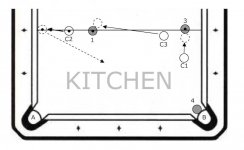Okay, I'll state this again. I'm not really sure why anyone is hung-up on the specifics of the diagram. I was simply illustrating a point. I can create a shot that falls under this category and I'm sure I can figure-out a way to manufacture a break-shot from it. I can also record it, post it to youtube and provide the link here. OR, you can go to a poolroom and try it yourself. Why is it so important that someone prove it can be done? It can be done. So long as the angle is greater than 90 degrees (which it is), it falls under the paradigm of acceptable angles and even then, others have proven you can go beyond this threshold. From there, you have speed and spin that can get you to the rack. Does it change anything if I move the balls around and get a break from it? Does it change anything if I have to go two rails? I don't think so. I think the point of the discussion remains intact.
I have an interest in extreme cut shots. That is all. Relax.
